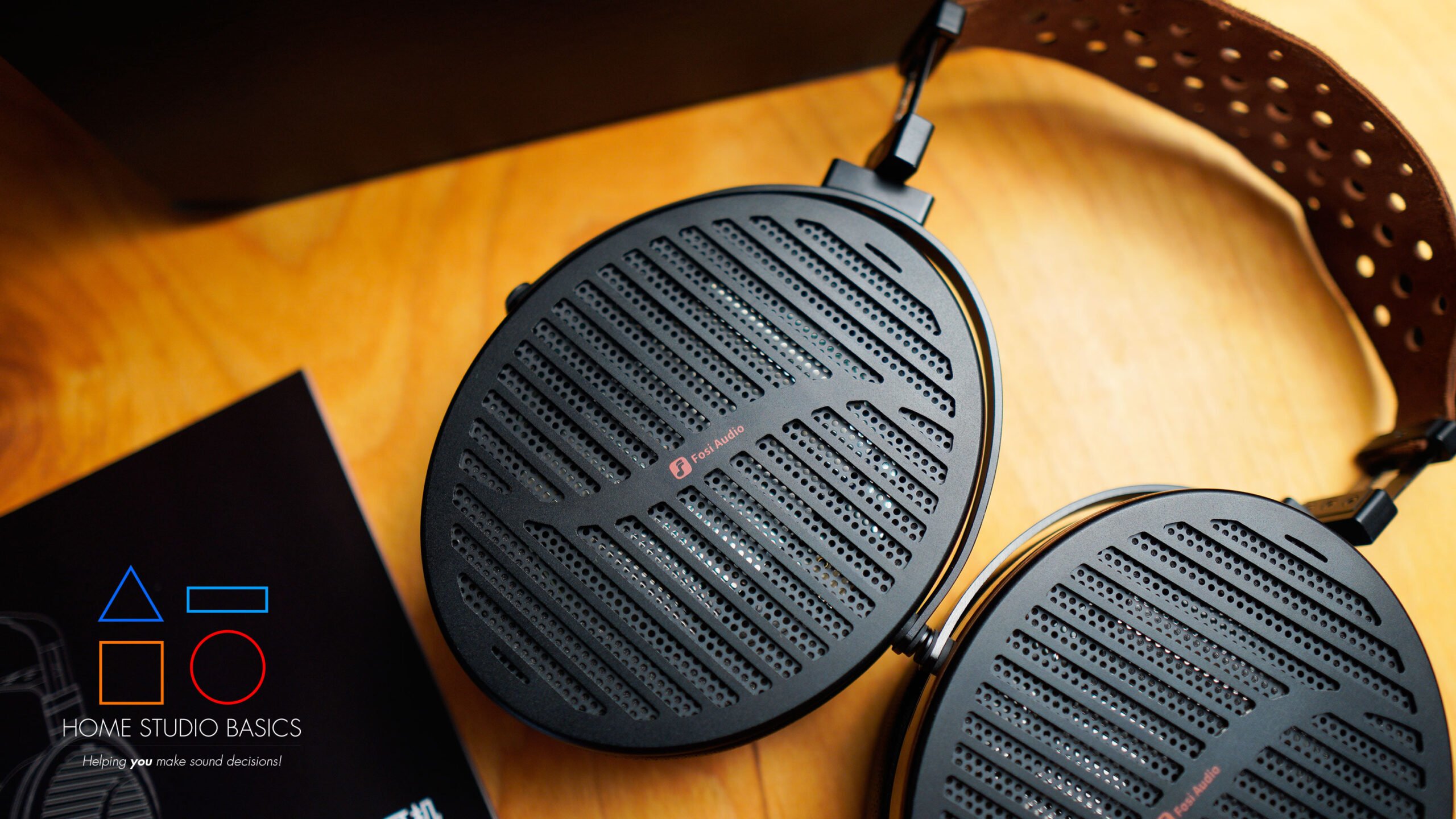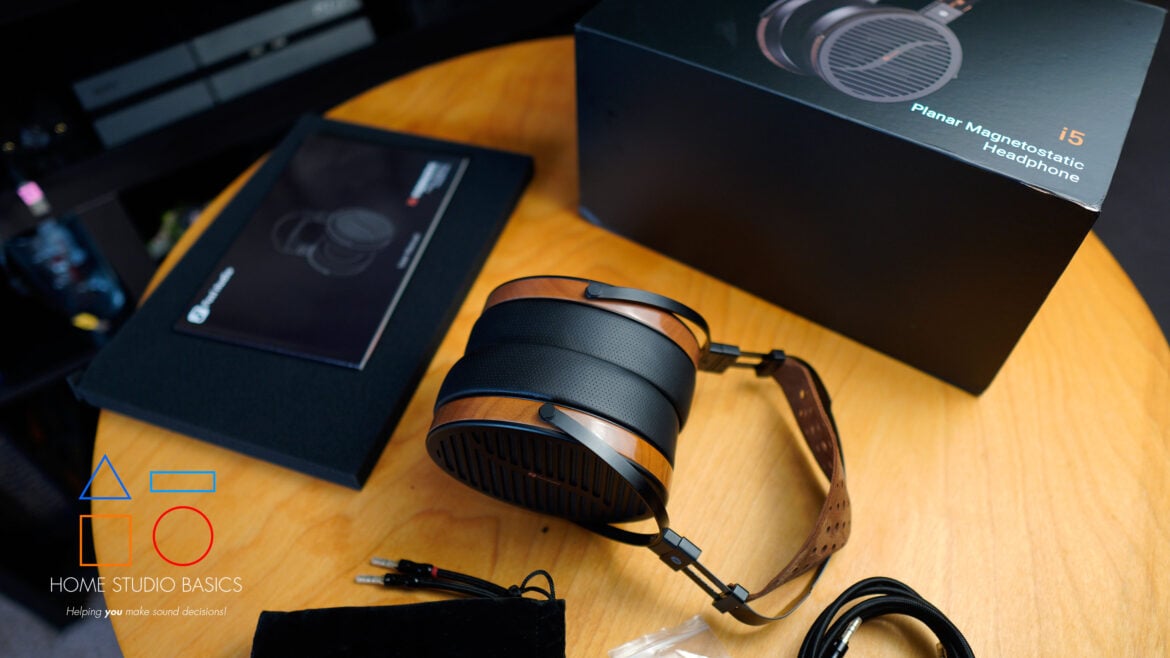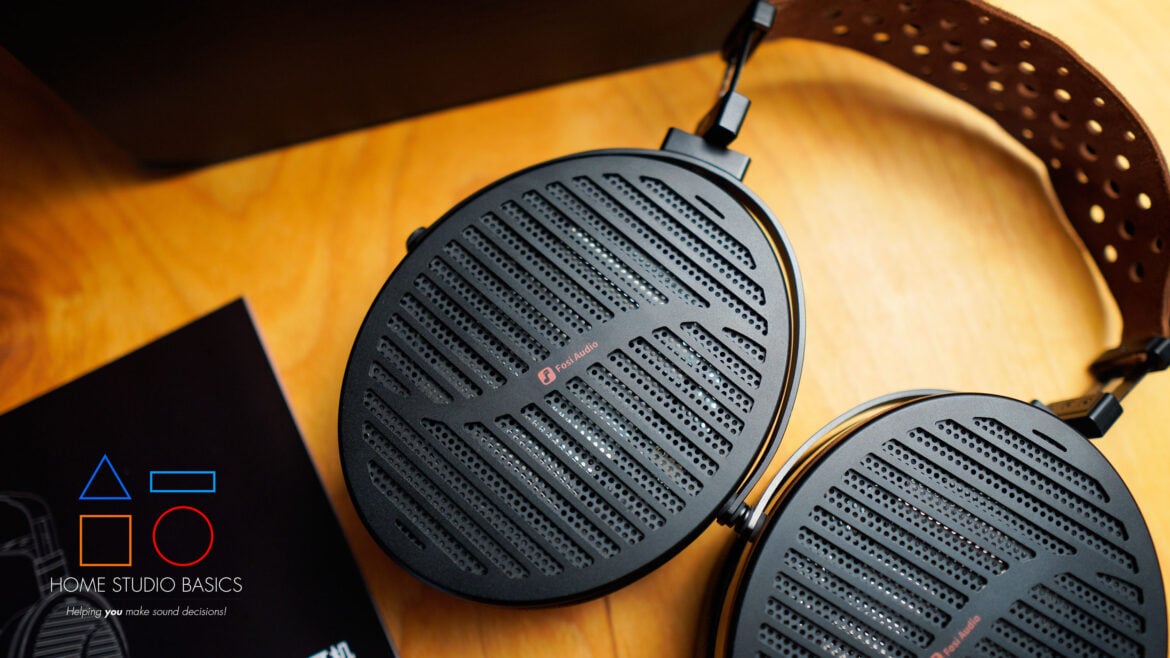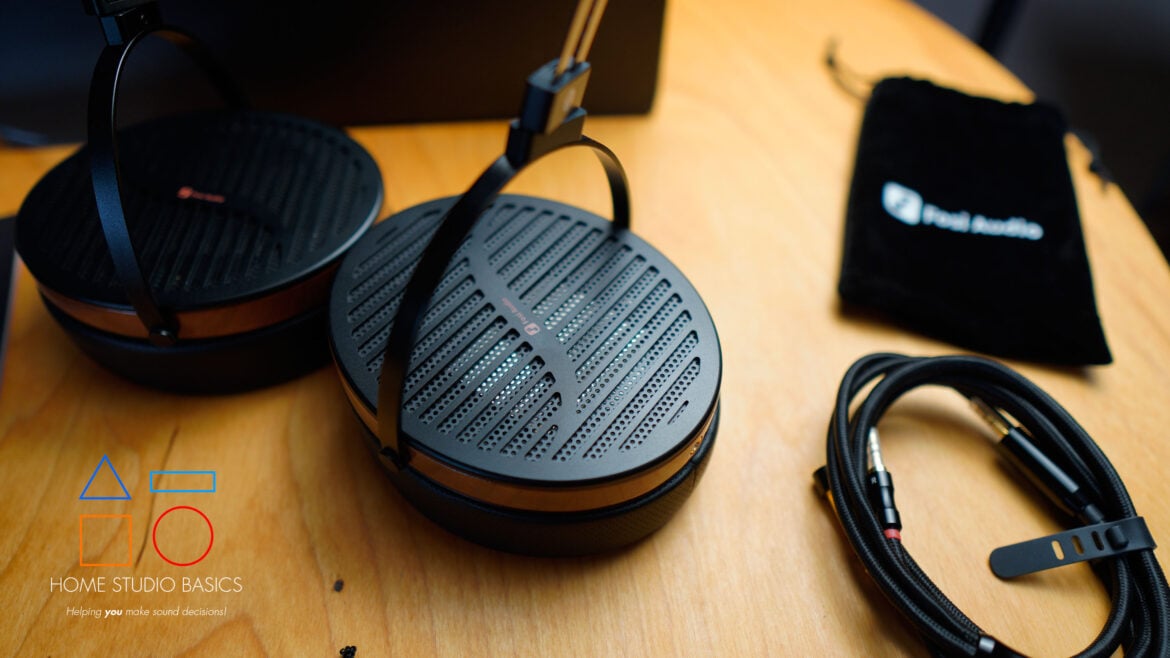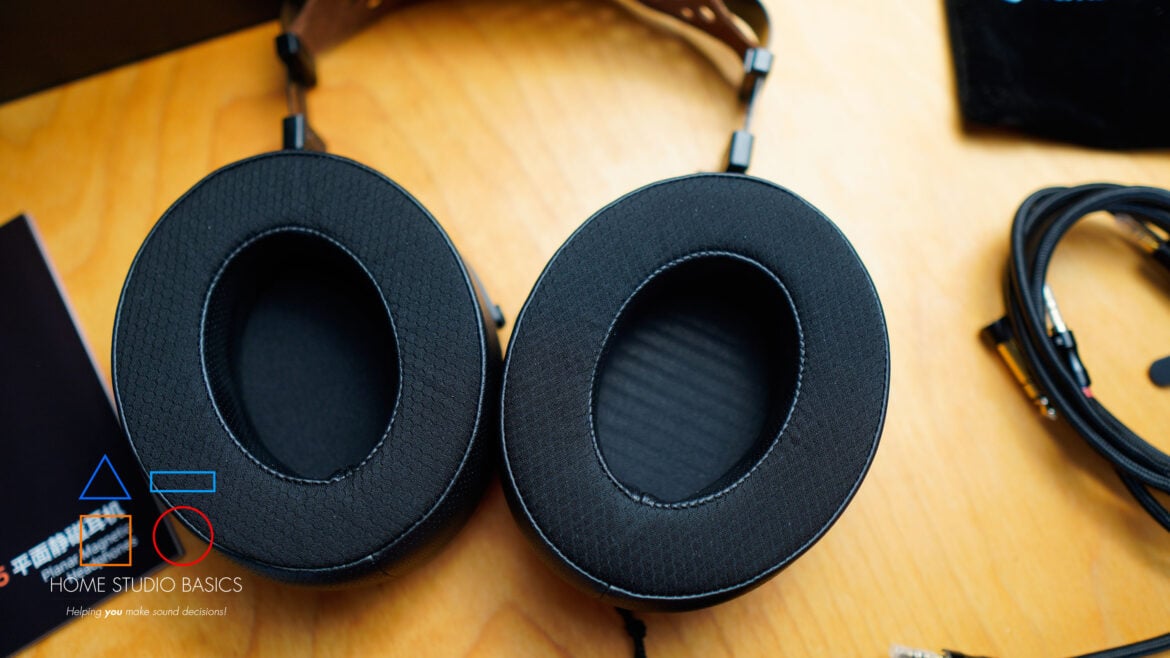Greetings mate and Welcome aboard!
Stuart Charles here, HomeStudioBasics.com helping YOU make sound decisions, so…
Video Discussion
Leave me some love and subscribe! <3
Today’s review highlights Fosi Audio’s i5, an open-backed, planar magnetostatic headphone with a lot of promise and an interesting aesthetic.
We’ll cover build, comfort, sound, resolution, soundstage, genre pairing, amplification needs, and more. I’ll also compare the i5 to some other popular planar headphones I have here, including the Ananda Nano and Arya Organic.
Additionally, the sound will be evaluated with and without Fosi’s isolating rings, which were manufactured due to some concerns of sub-bass leakage. We’ll get into all that, too.
By the time you’re finished reading, you’ll know if it’s worth a purchase. If it isn’t, I’ll point you in the direction of something that is.
With that, let’s dive in!
All specs, box contents, discount codes, and pricing toward the end.
Build Quality, Materials, & Aesthetic
To start, these headphones, in my opinion, are gorgeous.
Borrowing from HIFIMAN’s general Arya design, the bales, adjustment blocks, headband, and overall look somewhat mimic the Arya, and that’s certainly good news for people who love bad news.
The cups rotate down and around in a full 360º, adding to their overall malleability and fun-to-play-with vibe.
Moreover, the cups themselves are huge and even larger than any HIFIMAN headphone, offering DUMMY THICC pads x2 that are simply irresistible to push and press.
Both cables are braided and feel very rugged, but if experience has taught me anything, they may fray over time. I will update the article as I get more time with them.
The cable is also decently malleable and thankfully doesn’t hold its shape too much. This means you can move it around rather freely like Mr. McFeely, and it cooperates nicely after a small break-in period (gently stretch it out/bend it around for a few seconds to get it moving).
Moving into the headphones’ internals, the i5 features target sputtering coating technology and a 1.3µm ultra-thin silver alloy voice coil that, according to Fosi, meticulously reproduces energy with the utmost precision.
The i5 is also equipped with nano-scale 97mm round diaphragms, ensuring uniform force distribution along its edges, resulting in a robust and immersive bass extension.
The headphones utilize a precision-machined CNC aluminum mesh cover, offering protection for the internal components.
Likewise, the body is crafted with premium walnut board, and the micro-porous structure within can absorb harmful vibrations and suppress resonance. This will be important later when we dissect sound, so stick around like scotch tape and don’t press that back button, because I’LL KNOW.
Rounding out the build are designed silicone sliders, Aerospace-grade memory metal for the headband, fabric cushions, and perforated faux leather, which they claim together provide a large acoustic chamber and less pressure on your ears.
Speaking of pressure, let’s dive into comfort.
Comfort
As you can well imagine, the plush, soft, supple ear cups make the i5 a dream to wear.
Sure, the headphone is bulky and you’ll look and feel like Bobby Bouchee when you put it on your head, but it’s a small price to pay for the pillowy feel and soft, sweet nothings the headphone imparts into your auricles.
The cups aren’t just thicc. They’re DUMMY THICC and then some, easily thiccer than any of the other HIFIMAN varieties. That’s not to say HIFIMAN headphones aren’t comfortable. They are. But I would say that the i5 is at least as good and rests on your head very nicely.
That said, you will be making some minor adjustments, as I’ve found myself doing after around 45 minutes to an hour of session time.
Clamping force is just about perfect, and yes, they are heavy at 550g, but don’t feel heavy on your head (for the most part).
Unlike Audeze, both Fosi and HIFIMAN understand how to ensure even weight distribution in constructing a headphone that doesn’t feel like you’re wearing a 15 lb. bowling ball on your melon.
Despite the even weight distribution, you will start to feel them after extended listening sessions, but not necessarily to the point where you want to rip them off, as with, say, an LCD-2.
The headband is flimsy, but it feels nice to the touch and does its job well, securing your noggin in place without digging into the top of your skull.
Overall, comfort is excellent, and I have minimal to no complaints thus far.
Sound
- Amp/DACs Used: FiiO K7, FiiO K19, FiiO K11/K11 R2R, more to come.
- Source(s): Spotify, FLAC.
- Playlists: Here and Here
We’ll evaluate the sound with and without the isolation rings, and I’ll touch on balanced impressions later as well.
As always, (and as a producer) I’d like to preface this by saying PAY ATTENTION TO THE SOURCE FILE and how well the song was engineered.
Without a good mix/master, any song is going to sound like shit through any headphones, and that will never change, no matter what some audiophile dick hole tells you; one who claims he can hear the grass growing through his new favorite flavor of the week DAC.
Right off the bat, you’ll notice a couple of things:
Bass articulation
While not quite on the level of an Audeze LCD-2, this is planar bass through and through. It’s smooth, bottomless, and incredibly articulate.
DJ Premier’s “The Come Up (Instrumental)” is a perfect example of bass that sounds true, correct, clean, and textured. Bass on consumer products is mostly just a blob of indecipherable notes + loads of smelly poop, but the i5 highlights why taking the plunge and purchasing a planar is indeed worth it. It just sounds better, and a lot of this has to do with the very structure of a planar headphone and how the magnets are situated.
- Required Reading: Dynamic vs. Planar Magnetic vs. Electrostatic Headphones
I won’t delve too much into that now (click the article^), but just know that planar headphones are better at evenly distributing sound waves through the diaphragm, which results in minimal to no distortion, a clearer, better response, and improved resolution, timbre, etc.
And the i5 is certainly a beneficiary.
Cautious Clay’s “Tokyo Lift (5am)” is a great example of this. It sounds incredibly silky, natural, and buttery smooth; a hallmark trait of planars and a huge reason why they’re superior to dynamic headphones.
The original bass response without the isolation rings observes a correct boost in the all-important regions of 60-90Hz (where the slam/punch resides), followed by a cut at 200-300Hz.
Bravo, Fosi. Most comapnies f**k this up royally squared, so it’s a breath of fresh air that the i5 doesn’t suffer from any bloat, bleed, mud, etc.
Furthermore, the sub-bass at around 40-50Hz is rolled off, which is fine since we can’t actually hear frequencies in those areas and below. Some will argue you can “feel” it. Fine. Whatever.
But for any producers reading this, these are going to provide all of the information you’ll need and would make excellent reference headphones alongside some studio monitors like the Yamaha HS7.
In fact, the i5’s original FR is pretty much exactly how I recommend tuning and EQ’ing bass for production work, and I’m a huge proponent of it.
- Related: How To EQ Bass
Overall Bass Score: A/A+
There’s not much to complain about here, as the bass is one of the i5’s greatest strengths. With the sound isolation rings, it’s more of a flat line response and suited more for audiophiles, I guess, but again, you don’t really need that extra sub bass information, in my opinion.
The bass with the rings is more of a HIFIMAN type of tuning, but I’m not a huge fan of the rise at 200-300. That needs to be brought back down.
Note: I typically consider the bass to end around 200-300Hz, where the bloat/mud regions reside.
Mid-Range
This is where things get a bit interesting. From about 400 – 2kHz, some strange things are going on, and it looks weird from a graphical standpoint, but upon closer inspection, there’s a reason for it.
Let’s dive in.
400-600Hz
Odie’s “Noise” finds his voice coming through ultra crisp, clear, articulate, and with exemplary resolution and fullness. Eye popping. Whoa.
It’s not necessarily a negative, but the dip at around 400Hz sacrifices warmth for the above-mentioned crystal clear clarity.
Do I make myself clear, Mr. Bender?
CRYSTAL.
Still, I’d rather have clarity over warmth, as too much results in a muddy vocal sound, which we don’t want. So the vocals are off to an excellent start.
Additionally, you’ll notice a richness in acoustic instruments. They sound wet, dense, and very lush, contributing to an overall sense of body to songs that you simply won’t find in dynamic headphones.
One of my all-time favorite tracks, Emily Rowe’s “Pinball,” is a perfect example of a song that sounds nearly perfect through the i5.
Her voice feels intimate and close to you, the resoultion is astounding, but it doesn’t ever sound honky or nasally. Her vocals have raw power, with fullness and body to match.
In other words, you’ll have an easier time identifying with her and focusing on the feeling that’s supposed to emanate from what she’s saying.
700-900Hz
Fosi opts for a boost around 700Hz and a cut around 800, in effect adding a bit of forwardness without the boxy/nasally/honky character.
This is a running theme with the i5 overall, as vocals and instruments pretty much always sound correct, solid, and full.
This is apparent on the aforementioned “Pinball,” and “Noise”, but it also shines through with genres like prog metal.
For instance, guitars on Plini’s “Every Piece Matters” sound very natural and forward without the shout.
Speaking of shout, let’s move into the center and upper mid-range.
1000 – 5000Hz
There’s a reason HIFIMAN, in almost every headphone they’ve ever tuned, boosts the area around 1 kHz.
It’s key for vocal intelligibility and definition across most instruments, and, as mentioned in some of the other songs, the i5 has no shortage of it.
Like HIFIMAN, Fosi also opts for a boost here, giving the songs nice zip without sounding in your face or shouty.
The critical region of 2.5 kHz to around 3.5 kHz also sees a boost, giving vocals, transients, and overall presence a lift without fatigue.
Treble
One of the best aspects of the i5’s frequency response is the treble.
Loosely following the Harman target in some ways, it opts for a cut at 4-5kHz and a boost at 6.
The cut softens the edginess, aggression, and bite, while a boost at 6 adds some brilliance, air, clarity, and detail – especially in hi-hats, cymbals, and vocal overtones. It’s important not to overdo it, and Fosi doesn’t.
Cymbals and vocals have a crispness and articulation to them without the harshness and brittleness that can happen when they’re overly boosted.
Moving into the final regions of the treble, there’s a cut at 7-8kHz and a boost at 8.5-9, emphasizing and sharpening transients and vocal articulation/brightness and cymbal shimmer, adding crispness and clarity to the high end without introducing excessive glare, hiss, or brittleness.
This preserves clarity and brilliance while avoiding overexposure of high-frequency content that might otherwise sound metallic, glassy, or overly airy.
The regions around 10kHz and after are rolled off to reduce excessive air and tame the added harshness and sibilance that can accompany. I can understand and appreciate a couple of different approaches here (i.e., boosting this air region a bit), but the i5 handles the treble nicely overall.
Now that we’ve dissected the frequency response, let’s get into some other aspects of the i5 that are important.
Soundstage, Spacing & Separation
Hinted at earlier, the spacing and separation here are phenomenal.
While the i5 does highlight poor panning decisions in mixes, it also showcases good ones. Sounds are given ample room to breathe, and the Soundstage is portrayed well.
Now, for all of its strengths, this is still a fairly “head width” sound (perhaps slightly wider), meaning that the majority of tracks aren’t going to have that “out of your head” feeling where you start to believe that someone may be knocking at your door or something.
Related Video:
For me, this is one of the only disappointments, as I was looking forward to a Soundstage similar to something like a K702, but it doesn’t dampen the mood enough to get my panties in a twist.
The way instruments and vocals are placed on the stage is arguably more important from a technical standpoint, and the i5 delivers in this regard without issue.
Again, pay attention to the track and how it was engineered before blaming the headphones for any perceived shortcomings.
One notable exception is “On The Square” by Mac DeMarco; there’s a tapping at the end that kind of startled me, making me think it was coming from outside the headphones, but I’m pretty sure he mixed it like this on purpose. Some artists really love to mess with you, and it can be both exhilarating and horrifying at the same time.
Genre Pairing
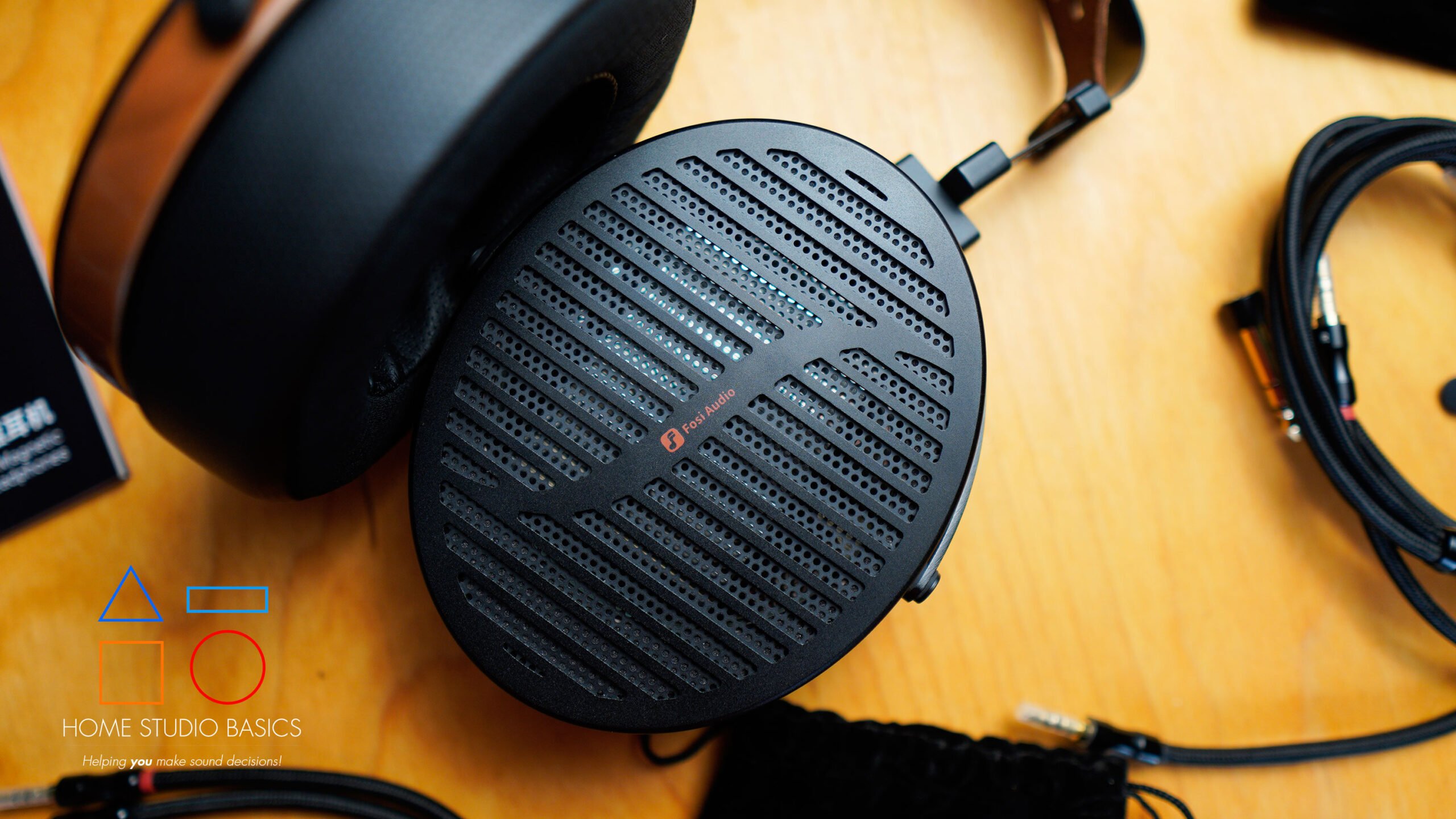
I think the i5 works well for an array of genres: Indie/Pop, Rock, Hip-Hop, Jazz, Classical, Ambient, etc. Whatever you happen to listen to most often, the i5 will likely work very well for you.
To me, it functions well as an all-purpose headphone, and much of this can be traced back to its open sound, planar drivers mentioned near the start, and their undoubtedly superior resolution.
As alluded to earlier, the i5 would also work very well for mixing and reference due to the fluidity of the entire sound signature, but most notably, the bass response is excellent for such a purpose, enabling you to make quick decisions on the boards.
Resolution & Timbre
Furthermore, songs like “Landslide” from Sufjan Stevens open up considerably. This song used to sound kind of blobby and lacking cohesion/clarity, but the i5 brings out the fact that it was mixed pretty well overall, despite the kind of “fuzzy”, abrasive nature of the track in general.
There’s a zippy-ish sound at 1:40 and 1:55 that comes through extremely well, and something that’s much harder to decipher in a dynamic headphone.
I should also mention that vocals in general are easier to interpret, another common trait and strong point of planars in general.
Likewise, instrument and vocal timbre are also exemplary.
You’ll start to really get a sense of the instrument or voice’s unique tone/inflection, i.e., what sets it apart from another instrument, or in the case of a person, what specifically distinguishes their voice from another’s.
The way I always describe it to people is how an instrument or voice may sound in real life vs. the way it sounds through drivers.
Planar drivers serve to bridge that gap and bring you closer to reality, another reason why some get stuck in the audiophile habbit role with no hope of ever seeing the light of day, ever again.
These are things that increase immersion and intimacy between you and the track. You may find yourself honing in on the artist’s unique voice and nothing else, as I did on Action Bronson’s “Sergio” (discussed more in a bit).
Amplification
With a measly 28 Ohm Impedance and 98dB/mW Sensitivity, the i5 is incredibly easy to drive, very efficient, and hardly needs much power from an amp to get pumping.
I used an array of Amps, and they all work very well. Don’t overthink it! If you need a hand in deciding on something, please leave a comment down below!
Balanced Impressions
In terms of the provided 4.4mm cable, expect slightly better resolution and a boost in overall clarity. This is a bit of a touchy subject, but I believe that from a scientific standpoint, balanced does make a difference both in technical terms and in real-world listening scenarios. I base this on many years of listening to balanced studio monitors and headphones.
Sounds simply come alive like Peter Frampton, and although it can be subtle, it’s definitely noticeable if you’re truly focusing on the music at hand.
Sound Comparisons
Fosi Audio i5 vs. HIFIMAN Ananda Nano
On Xavier Omar’s “Blind Man,” one of my top test tracks for clean bass slam and impact, treble clarity with hats and cymbals, and overall excellent resolution of vocals and instruments, the difference is immediately noticeable.
The Ananda Nano sounds more crisp and open, coming across as cleaner, with a sense of sterility vs. the warmer tone of the i5.
The Nano is bitier and a bit essier than the i5 as well.
In other words, you can tell that more emphasis was placed on brilliance and sparkle in the Nano’s tuning, an ongoing debate in the Ananda variants (i.e. whether it’s ultimately good or bad) ever since the OG version came out around 2019.
If you’re looking for a snappier rendition, I do think the Ananda Nano edges the i5, but in terms of tonality, resolution, and overall tuning, they’re pretty much neck and neck.
If you dig a warmer tone, the i5 is your homie.
I think width is slightly larger on the i5, which is strange considering I believe the Nano to have above average Soundstage (not amazing or anything). This experienced phenomenon could be, and is likely due to the proximity of the i5’s drivers to your ears and the fatter ear cups.
On “This Means You” from Mos Def & Reflection Eternal, bass slam and impact are a bit crisper and hit harder on the Nano, but both provide excellent renditions of the low end, and both strike with good authority.
Again, the i5 has this sheen of warmth and a somewhat less resolving character, but this simply could be the Nano’s brighter overall portrayal, as mentioned earlier. Sometimes you may think brighter = better resolution, but that’s not always the case.
Interestingly enough, I think the i5 does a bit better job with spacing and separation as the Nano feels a bit closed in on this track in particular.
On Jimi Hendrix’s “Wittle Ling”, and J Dilla’s “Yesterday”, (the latter of which is also a top test track due to its excellent mixdown), the overall sentiment is that the i5 is more open and a touch warmer, while the Nano is more closed in and somewhat crisper and more sterile.
I personally believe vocal clarity and forwardness are very similar, and the emphasis at 1 kHz on both would seem to validate this sentiment. In other words, you’re probably going to have a pretty hard time deciding which sounds “better,” as again, they’re both very similar in a lot of ways.
Related Video:
Fosi Audio i5 vs. HIFIMAN Arya Organic
Like the Ananda Nano, the Arya Organic boasts a tighter rendition of Dilla’s “Yesterday,” but the resolution is also a bit better than both the Nano and i5.
The variation in the beat can be heard at 38 seconds, but part of the sample in the background is deciphered with greater clarity through the Organic, providing better resolution, which can also be heard on Action Bronson’s “Sergio.” In one of his ad libs, you can clearly hear him say “pop off” at 40 seconds (after “Jack in the Box”), which simply cannot be heard with any degree of clarity in dynamic headphones.
That said, the i5, by contrast, is slightly hazier sounding, with less overall definition and a bit of a flabbier presentation. And even though the resolution is good, it’s just not as good as the Organic.
Bronson has never sounded more gruff and grimey, as the Organic really showcases the grittiness of his voice, which comes through better on the Arya.
That said, these observations are incredibly laser-focused and not indicative of the i5’s overall quality. It’s still a great headphone, just outclassed a bit in this instance.
The i5 is more open than the Organic, and the Organic is more open than the Nano, but it’s pretty subtle.
This is further finalized on Hazel English & Day Wave’s “Jesse.”
The i5 again provides a wider space for the music to exist in, but comes across as a bit hazier, while the Organic gives you snappier guitar presentation and cleaner percussion hits. Vocals stand out a bit more and also feel a little closer to you with the Organic, but again, both headphones have great resolution overall, with a slight edge to the Organic.
Decay & Release
With planar headphones like these, you’ll notice the decay and release of vocals and instruments as well. Voices trail off beautifully, and guitars feel fully fleshed out. You’re able to get a true sense of the instrument’s unique tone, but this also applies to vocals as well (as heard in the “gruff” and grit of Action Bronson’s voice).
Related Video:
Before we give a final verdict, let’s quickly go over some things I like and others that can be improved.
What I liked:
- Excellently tuned. Though a bit weird looking from a graphical standpoint, Fosi tuned these with a purpose in mind.
- Resolving and revealing. Because of their planar profile, the resolution is excellent and much better than a dynamic headphone. This is an honest sound, which highlights flaws in recordings but also showcases good mixes and masters.
- Built well and comfortable. Despite their 550g stature, weight distribution is superb, and they don’t feel like a bowling ball. They’re also very rugged and seem to be constructed very thoughtfully.
- Good accessories. The cable ties aren’t twist ties, and the manual is a nice booklet.
What can be improved:
- There are some spelling errors in the booklet, and though a minor annoyance, they should be cleaned up.
- Soundstage is decent, but not as good as I was expecting. I will update this article if anything changes, but I didn’t experience many of those “out of my head” moments, and it left me a tad disappointed.
Final Verdict
Fosi Audio’s i5 is a wonderfully built, comfortable headphone with fantastic resolution, excellent tuning, and a product worthy of its planar moniker. The bass is handled extremely well, and the thoughtful tuning should leave most listeners completely satisfied like a Snickers.
Whether you’re listening to the hard drum kicks and bass inherent in hip-hop or the delicate strokes found in Jazz, the i5 works for an array of genres and comes with a 4.4mm balanced cable to boot.
Fosi Audio i5
Price: Check Fosi Audio! (Use Code FAI5MKT15 for 15% OFF (Expires 9/15/25) | Check Amazon!
Check eBay! | Check Aliexpress! | Check Walmart! | Check Newegg!
In The Box
Fosi Audio i5 Headphones
User Manual
1x 3.5mm Cable
1x 4.4mm Cable
Specifications
- Transducer Type: Planar Magnetic Transducer
- Maximum SPL: ≥ 120dB SPL
- Frequency Response: 10 – 50,000 Hz
- THD (Total Harmonic Distortion): < 1% @ 100dB SPL
- Sensitivity: 98dB/mW @ 1kHz
- Nominal Impedance: 28Ω
- Recommended Power: ≥ 500mW
- Minimum Power: 100mW
- Weight: 550g
Well, that’s about it for today my friend! I hope you’ve enjoyed this Fosi Audio i5 Review and came away with some valuable insight.
Questions? Comments? Requests? Did I miss the mark on something? Please leave them down below or Contact me!!
If you love what I do here and want to support the blog and channel in a more personal way, check me out on Patreon and discover all the value I have to offer you.
Is the i5 a worthy planar magnetic headphone? What are your experiences with planars? I would love to hear from you. Until next time…
All the best and God bless,
-Stu






